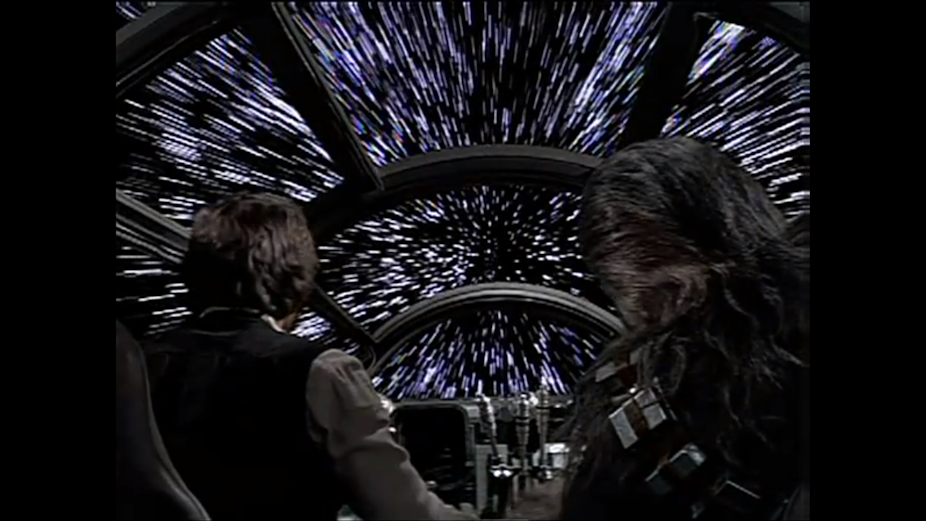Fans of science fiction must be disheartened when introduced to Einstein’s Special Theory of Relativity. Dreams of galactic empires, criss-crossed by roguish princesses and beautiful smugglers, go out the window with one simple rule: “thou shalt not travel faster than the speed of light”.
Even a rocket ship travelling just under the speed of light (roughly 1 billion km/h) would take more than 100,000 years to get from one side of the Milky Way to the other. That’s slightly longer than the fraction of a second required to traverse galaxies in science fiction staples such as Star Wars.

Of course, we are a long way from being able to build spacecraft that can travel at 1 billion km/h – the best we’ve been able to manage so far is roughly 60,000km/h, the speed being travelled by Voyager 1 as it currently speeds away from Earth.
Even if we could build a near-speed-of-light spacecraft, the effects of time-dilation would pose a real problem. This dilation, according to Special Relativity, ensures clocks on our almost-light-speed rocket would run more slowly than those left behind on Earth.
When you returned from your galactic travels, even though only a few decades had passed for you, everyone you knew before would be dead, and even the civilisation from which you came would have probably passed into history.
While science fiction has come up with creative ideas to circumvent the speed-of-light barrier, such as travelling through “hyper-space” or zipping through a wormhole, science fact appears to be bound by Einstein’s light speed law.
And while this law can’t be broken, it seems it can be bent.
In 1994, Mexican physicist Miguel Alcubierre used Einstein’s General Theory of Relativity to show that if you wrap a rocket in a bubble of distorted space-time (see image below), the rocket can travel at any speed through the universe.
It can achieve this by (in hand-wavy terms) compressing the space in front of it, and expanding the space behind it. Voila: a warp-drive worthy of the world of science fiction!
Within the bubble, rocketeers would comfortably float in a weightless environment, and would not suffer the time-dilation of high-speed rockets. This is a bonus for those who like to keep their diaries in check, and for those who want to see their nearest and dearest when they return to Earth.
The Alcubierre warp-drive looks like it solves the problems of building a Galactic Empire (although there are some issues that ensure building one will require technologies and knowledge far in excess of our own).
Putting practical considerations to one side, would there be any negative consequences of using such a warp-drive? This is a question I asked with two of my honours students, Brendan McMonigal and Phil o’Byrne.

Our starting point was the realisation that the space through which a warp-drive would fly is not truly empty. Rather it’s a tenuous sea of atoms and radiation, even in the space far away from galaxies. So what would happen when a warp-drive rocket ploughs through this sea?
Our key concern was for the rocketeers themselves. If the atoms and radiation make it into the rocket, and their energies are boosted by their journey through the warped space-time of the bubble, the resulting irradiation would fry the occupants. This would not make for a pleasant trip.
By using the equations of relativity, we traced the passage of the particles as they encounter the bubble, and found that, in general, the rocketeers would be fine. They would receive a dose of radiation no worse than usual space travel (although this can be quite dangerous).
But as we increase the speed of the warp bubble, pushing into “superluminal” (faster-than-light) travel, something quite interesting happens. As the ship runs into particles and radiation, these particles make their way into the bubble, but get stuck before reaching the rocket at the centre. As the ship progresses, it sweeps up more and more material which continues to accumulate in the bubble.
Even though these particles and radiation are fixed with regards to the rocket, their energy starts to grow, and grow, and grow.
This is fine as long as the warp-bubble keeps moving. But clearly, if your aim is to establish a Galactic Empire, you’ll want to stop every now and then to explore your conquests. Unfortunately, in slowing down, all of the matter and radiation caught up in the bubble – whose energies have been boosted to extremely high levels – would be released in a deadly beam in front of the ship.
So, while the rocketeer would remain safe throughout his or her superluminal journey, the energy burst released when they slow down would fry whatever they’ve stopped to admire. Such an energy blast could even sterilise the planet they were hoping to visit.
While this may disappoint the rocketeer (and the residents of the now-fried planet), it would be nothing compared to the fact Earth could be destroyed by the return journey.
The warp-drive has become a death machine!
From the outside, it might be difficult to separate science fact from science fiction, but all of this work is based within the framework of Einstein’s General Theory of Relativity – the most accurate description we have of gravity.
In 2016, Einstein’s work will be 100 years old, but the complexity of the equations means we have only started scratching the surface of what is truly possible.
We shouldn’t write off the Galactic Empire just yet.
Further reading:
- The warp drive: hyper-fast travel within general relativity - Miguel Alcubierre

